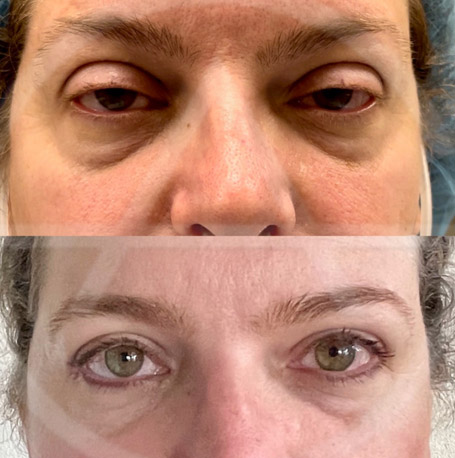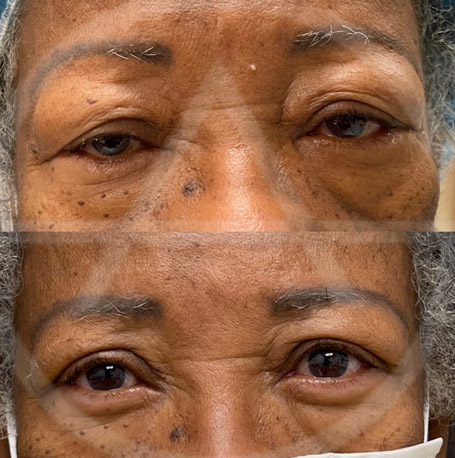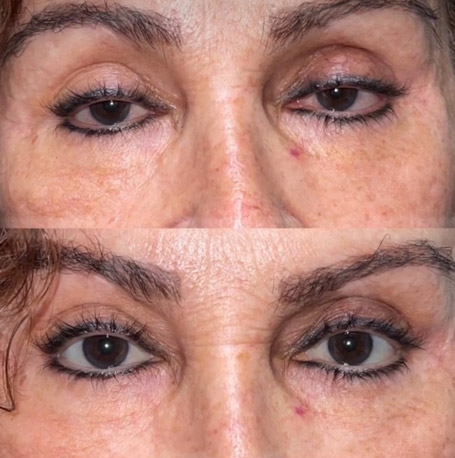
Ptosis Repair Surgery
Table of ContentsToggle Table of ContentToggle
What Is Eyelid Ptosis?
Eyelid ptosis, commonly known as droopy eyelids, is a condition in which the upper eyelid droops or hangs down lower than normal. It can affect one or both eyelids and ranges from mild to severe, and in some cases, it can even impair vision if left untreated.
The cause of ptosis may be acquired or congenital, meaning present at birth. Acquired forms of ptosis can range from natural aging changes, trauma, neurological processes, underlying medical conditions, contact lens wear, and more. In all cases, the cause leads to a weakness in the levator or the Müller muscle. These muscles are responsible for opening the eye, so any weakness in either can result in visible changes to the eyelid’s appearance and position.
How Does Ptosis Repair Work?
At Dr. Avila’s practice for oculofacial plastic surgery in Miami, she offers various types of ptosis repair surgery to correct droopy eyelids. In traditional ptosis surgery, the procedure typically involves repositioning and tightening the levator or Müller muscle and adjusting the eyelid’s structures to make it easier to open. Additionally, it may involve removing fat and skin from the affected area to lighten the load on these fragile muscles.
Dr. Avila matches her patients with one of the several types of ptosis repair available, depending on their individual situation. In each case, surgery can help lift the drooping eyelid, restoring a more natural position that looks both more rested and more alert while improving vision.
Standard Ptosis Surgery:
- Internal: Tightens the muscle through an incision beneath the upper eyelid for no visible scarring.
- For milder cases
- External: Incision is made through the eyelid crease, and the muscle is tightened.
- For patients with more pronounced ptosis
Specialized Ptosis Repair:
- Frontalis Suspension Technique: In rare cases when the muscles are paralyzed, too weak, or damaged beyond repair, a frontalis suspension technique may be necessary.
Why Choose Ptosis Correction?
Ptosis correction can prove the perfect solution for patients looking to see better, look better, and feel better. It can also help with subtler effects of droopy eyelids, such as reducing neck strain (caused by tilting the head to see) and eye fatigue (caused by difficulty in focusing vision). The procedure also improves vision by allowing for a better eyelid contour and opening the eye for a wider field of vision.
Additionally, the procedure can have a positive impact on one’s appearance, eliciting a more alert and youthful expression. While many of the benefits are functional, there is no denying the lasting impact of the procedure’s cosmetic changes as well.
Benefits of Ptosis Surgery in Miami
- A more attractive, youthful look
- Improved vision and better eyelid contour
- Reduces miscellaneous symptoms of droopy eyelids
- Minimal discomfort during recovery
- Long-lasting results that look natural
If you are considering ptosis surgery in Miami, Dr. Avila is proud to offer this service, serving her community through individualized treatment plans.
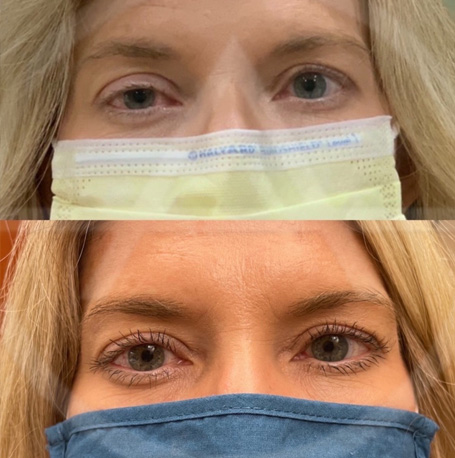
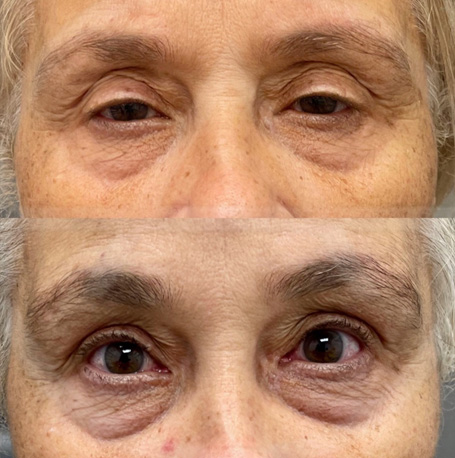
Am I a Candidate for Ptosis Repair?

- It is important to rule out serious causes of ptosis such as stroke, tumor, and other neurovascular causes. Thus, choosing a board-certified fellowship-trained oculofacial surgeon for your eyelid surgery is vital.
- Ideal candidates will also be in overall good health and non-smoking, as these factors influence recovery, risk, and final results.
The choice to undergo surgery is a deeply personal one, but it is a decision that can prove rewarding for years to come when made at the right time and with the right mindset. Dr. Avila and her staff take the time to provide complete information to every prospective patient, allowing them to make their decision without a rush and with full confidence.
Ptosis Surgery Procedure Overview
- Duration: The ptosis repair procedure is typically performed under local anesthesia with light sedation and takes 1-2 hours to complete.
- Process: In an external ptosis repair approach, the incision is made on the eyelid skin, and the levator muscle is adjusted. This will leave a scar that will fade with time. In internal eyelid ptosis repair, also known as scarless ptosis repair, the operation focuses on the Müller muscle. The incision is made from the inside of the eyelid, leaving no visible scar. In rare cases where the muscles are too weak or damaged beyond repair, a frontalis suspension technique may be necessary. The exact details of the procedure and best approach type will depend on your individual case.
- Post-Procedure: Following your procedure, you can return home the same day with someone to drive you.
- Combinations: Ptosis repair can be combined with upper eyelid blepharoplasty, lower eyelid blepharoplasty, brow lift, and other procedures for best results.
Preparing for Ptosis Surgery
How Long Is the Recovery?
Recovery time for ptosis repair surgery can vary, but most patients complete their initial recovery and downtime within a few days to about 2 weeks. During the first few days after the procedure, you should expect swelling and bruising around your eyes, but applying cold compresses can help reduce this discomfort. Dr. Avila may prescribe antibiotics or other medications to minimize any post-operative risks, but over-the-counter pain medication is typically enough to manage any discomfort. You will also need to avoid strenuous activity for a couple of weeks, and most patients take about 1-2 weeks off to allow for rest and a focus on recovery. After a follow-up visit with Dr. Avila, you will receive updated care instructions and information about when to return to your normal routine.
When Will I See the Results?
Are the Results Permanent?
Can You Combine Ptosis Surgery With Other Procedures?
Yes, ptosis repair can be combined with other procedures to create a more natural and youthful look. Some of the most popular combinations include brow lift surgery, eyelid lifts, and laser treatments. Dr. Avila will work with you to determine the best approach based on your individual needs and desired outcomes.
For patients who want to have upper eyelid surgery or Asian eyelid surgery, they may need to have these procedures separate from ptosis repair, as each procedure affects different structures in the eyelid. However, each case is unique, and Dr. Avila will fully explore your options with you according to the outcomes you want to experience.
How Much Does Ptosis Surgery Cost in Miami?
The cost of ptosis repair surgery in Miami varies depending on the complexity of your case and other factors such as the facility and anesthesia fees. During a consultation at our office, we will assess your individual needs and provide an accurate estimate for the total cost of your procedure so there are no surprises. In some cases, patients may be able to bill the procedure to insurance, particularly if their eyelid ptosis has begun to impact their vision drastically. However, these cases may warrant further testing for insurance purposes.
We work closely with each patient to find the best way for them to cover the costs of the procedure, from insurance to financing options, ensuring they receive the quality care they need.
Take your first step toward a life free of ptosis by booking your initial consultation with Dr. Avila today. Discover how working with a board-certified oculofacial plastic surgeon can open new doors and deliver a revived look to your eyes. Contact us today to schedule an appointment with Dr. Sarah Avila and get started on your personalized ptosis surgery in Miami.

Sarah Avila, MD
Specialization: Eyelid Surgery & Aesthetics
Dr. Sarah Avila is an oculofacial plastic surgeon in Miami, Florida. After completing medical school, Dr. Avila completed a residency in ophthalmology at the Mount Sinai Hospital, followed by a highly competitive two-year ASOPRS-accredited fellowship in reconstructive and cosmetic oculofacial surgery at Emory University. During this fellowship, Dr. Avila focused on plastic surgery related to the eyelids, brows, lacrimal duct system, orbit, and face.


